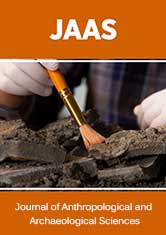
Lupine Publishers Group
Lupine Publishers
Menu
ISSN: 2690-5752
Research Article(ISSN: 2690-5752) 
The Spiritual Kingdom of Shambala from the Religious Views Volume 10 - Issue 1
Wanpeng Sun*
Independent Researcher, Newfoundland, Canada
Received: September 09, 2024; Published: September 16, 2024
Corresponding author: Wanpeng Sun, Independent Researcher, Newfoundland, Canada
DOI: 10.32474/JAAS.2024.10.000327
Abstract
Shambala, also spelled as Shambhala or Shamballa, is a realm that was mentioned in several ancient literatures. According to those literatures, there is a country in Shambala, ruled by a king. All people in Shambala are practicing Kalachakra (time wheel), a Buddhism religion. Nonetheless, there are no modern records to testify where it is. Currently, it is deemed as a spiritual kingdom, imagined by religious people. Shambala is mentioned in the Kalachakra Tantra as well as other religious books. For example, the Bon scriptures mention a closely re-lated land called Tagzig Olmo Lung Ring. Around 17th century, Europeans got to know the name of Shambala. Since then, the beliefs of Shambala have been there for centuries and spread widely in Western. Nowadays, there are hundreds of organizations named themselves as Shambala…… It is believed to be a physical place by some learned scholars. After all, where is Shambala? We can find some clues and its legendary history from the religious points of views. The formal nomenclature for Shambala is literately translated as the Shambala Illu-sory Continent. In addition, the author did not agree with some ideas that the Shambala is just a small village, but proposed that Shambala is not on our earth but is in outer space. There could be special (time-space) connecting tunnels. This is why it has not been physically discov-ered yet.
Keywords: Shambala, Buddhism; Time Wheel; Kalachakra; Sex Tantra; Union Practice; Trantrayana; Holy Bible
Introduction
Shambala (Sanskrit:, IAST: Śambhala), also spelled as Shambhala or Shamballa, is a realm that was mentioned in several ancient literatures. According to those literatures, there is a country in Shambala, ruled by a king. All people in Shambala are practicing Kalachakra (time wheel), a Buddhism religion. Nonetheless, there are no modern records to testify where it is. Currently, it is deemed as a spiritual kingdom that is imagined by religious people.
Shambala is mentioned in the Kalachakra Tantra as well as other religious books. The major Shambala narrative is found in the Kalachakra Tantra, a text of Buddhism Tantras. Kalachakra Bud-dhism was introduced from South Assia to Tibet in the 11th century. Kalachakra belongs to the anuttarayoga (nothing-above yoga), the highest meditation system in Buddhism tantra [1]. In Tibet, the oldest known teachers of Kalachakra are Dolpopa Sherab Gyaltsen and Buton Rinchen Drub, whose original lineages are from India. In India, the oldest known teacher is the Zilu Pandita (meaning: a scholar named Zilu), who got empowered by the King of Shambala. How did the King of Shambala traveled in order to give Zilu Pandita the empowerment? It is unclear. After Indian and its surrounding areas were conquered by Muslims, the original records were disappeared. In Tibet Buddhism, many reputable monks had studied abroad in the famous India’s Nalanda University, which was home to nine million books. Hundreds of years after the Muslim Conquest, the remains of Nalanda were re-discovered by Europeans, but it only has relics without books [2].
According to the narrative of Kalachakra Tantra, there are human societies in Shambala, ruled by a king. One of King is the King Manjuśrīkīrti (Figure 1), who made significant contributions to preach Buddhism. He was born in 159 BC and ruled over a kingdom with many followers. At that time, there are two group of people with two different religions in Shambala: one is Buddhism and the other worships the Sun. For Buddhism, Shakyamuni Buddha was preaching in Shambala. But the narrative did not mention where the Sun-worship group came from. As a matter of fact, Sun-Worship is a popular reli-gious practice in ancient Egypt and Atlantis. It is speculated that there were also communications between Shambala and other civilizations. Finally, King Manjuśrīkīrti preached Buddhism and turned those Sun-worship people into Buddhists.
Figure 1: Manjuśrīkīrti, one of distinct kings of Shambala who made significant contributions to preach Bud-dhism.
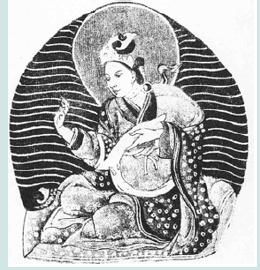
Currently, there are thousands of literatures discussing Shambala and some scholars, like Edwin Bernbaum PhD, insisted that Shambala should be a physical place rather than just a spiritual imagination; however, none of them reveal the real location to public. Many famous monks are preaching Kalachakra Buddhism all over the world; according to their teachings, the disciples with good faiths will be reborn into Shambala Kingdom, where humans live longer than their counterpart on this earth but there is still the traditional caste system like the ancient Indian. Those who have faiths but disobeyed the disciplines are likely to be reborn into the Sudra class, who will serve higher classes by working as slaves. In order to be reborn into a higher class and enjoy a meaningful life as happy as in paradise, the disciples have to work hard to practice the dharma and follow the doctrines. Hundreds of years ago, one of famous lamas wrote a book “in-depth” descripting the directions to Shambala. It is hard to verify the directions before the Modern Scientific Revolution. Nowadays, there are satellites, drones, airplanes, SUVs and all kinds of modern climbing/exploring equipment. However, Shambala was not found by modern technology, even following the directions. From religious point of view, this could be due to the limits of modern technologies; however, without direct evidence to show the location of Shambala, such teachings are only treated as religious opinions (not reality) and the Shambala is still deemed as a spiritual kingdom (imagination). This article will discuss the potential presence and location of Shambala, as well as its the legendary history.
Legendary History and Potential Locatoin of Shambala
Where is Shambala? Scientists did not know, and there is no direct evidence like a satellite image to show this country. Another explanation will be: it is not located on the earth, so there is no available satellite image. Through history, there are a number of observations/clues that could indirectly indicate the presence of this realm. For example, there is a special calendar called Tibetan Kalachakra calendar, which is believed to originate from Shambala. It is different from most solar and lunar calendars. Though there are some differences between its calculation and NASA’s data, it still can be used as a calendar in Tibet. The differences could cause by technical errors or the difference between the location of earth and the actual location of Shambala – it is speculated that the Shambala might not on the earth, although it is not far. Some learned scholar can add a special star called Rohu in the calendar to predict the actual dates of the solar eclipse and lunar eclipse [3]. Their explanation for ellipses is very unique but sounds more rational. Like modern scientific view, an eclipse occurs when three celestial bodies align: the Sun, the Moon, and the Earth. However, such alignments happen every month, but not necessarily to cause an eclipse. There is an invisible star called Rohu which can block more lights that caused obvious shadow effects during the eclipse. That is why this calendar uses Rohu to calculate eclipse and the prediction of eclipse dates turns out to be accurate. Anyway, it provides a different point of view on astrophysical phenome; such unique calendar is different from all popular calendar. Thus, it could come from an unknown realm like Shambala. For another example, the well-known novel Lost Horizon is derived from the legends about Shambala as heard by the author James Hilton. The similar case has happened in ancient China as documented in Peach Flower Origin Record by Tao Yuan Ming (365–427 A.D.), a reputable scholar, as a non-fiction documented record. Basically, somebody accidentally went into a beautiful place, and then returned home. Later on, he came back but cannot find that place. If the story is true, the rational scientific explanation will be: he accidentally entered the entrance of a space-time tunnel leading to a different world. The tunnel could be invisible and the door is indistinguishable. When he came back, he needed to search for the door rather than the place. This could be one of reasons why Hilton writes a novel instead of filing a case report since it is not repeatable and hard to believe.
Currently, the popular idea thought that Shambala is still a human realm, even though it has not been discovered yet. According to the third Panchen Lama Ensapa Lobsang Dondrup, the Shambala can refer to different things: it could refer to symbol for Kalachakra practice, a spiritual belief and/or an actual physical location. There are three ways to reach there: 1) reborn to there; 2) physically finding the place; 3) special tunnel (space-time) travelling. Comparing with the aforementioned reborn approach, the physical finding is a more understandable approach for modern humans. In Western, there are three known explorations aimed to discover Shambala, respectively initiated by Nicholas and Helena Roerich, French Buddhist Alexandra David-Néel, and Hitler. They searched Himalayas and surrounding regions, Altay Mountain and Afghanistan. Neither the Roerichs nor the French Buddhist found Shambala. It is unknown whether the German teams found it or not. But, to date, the well-preserved photos about the Tibet society in 1930s were taken and archived by Germany. In Western countries, the best translation about Tibetan Tantrayana, especially Kalachakra, is in German language rather than other languages, because there are secret practices of Kalachakra which will not be revealed to general translators who have not enough tantra practices. Anyway, the teaching of Kalachakra (time wheel) is translated into German language more than half century ago. In Tibet, there is a cave where documents were found about Atlantis, an ancient civilization that is too far away. Hitler believed there are pure Aryan people in Shambala. It is unclear whether they find something.
For Buddhism masters who have high meditation practice, they can see the special tunnels and go Shambala via these tunnels. Via Vajrayana practice, those monks can form an illusory body, according to Master Tsongkapa who is the most-holiness monk in Tibetan Buddhism. The illusory body is somehow like an invisible drone; the master can control this illusory body to go anywhere deliberately. It is noteworthy that the illusory body is not truly “invisible”, but hard to be seen by an ordinary person. According to His Holiness Master Tsongkapa, the union (sex tantra) yoga practice is essential in order to achieve the higher meditation status that can produce the illusory body. The union yoga practice is one of best-kept secrets and only can be taught to a handful “qualified” disciples. The teaching can only go by “Kagyu” (meaning: from month to ears), not supposed to write down. Usually only one of the best disciples can get this special teaching and that student is required to keep the secret by not telling any-body else. Even though one disciple got this teaching, that disciple cannot find another “qualified” partner for union practice; thus, there are only very few masters who can reach the illusory-body stage. Using the illusory body, the meditation masters can go through theses tunnels. When they come back, they describe the scenic view of Shambala, write down what they heard from Shambala people and draw the stories into Tangka (Figures 2-9). Tangka refers to the religious painting in the Tibetan culture.
Figure 2: The Tangka illustrating one of Dharma Kings of Shambala. Since the time of Siddhartha Buddha, the King of Shambala started practicing meditation and teaching dharma, so the king was called the Dharma King. The Tangka illustrates his palace, where he teaches in the lower level or outdoor and practice meditation in the higher level. There are gardens around his palace. At the upper left corner of this Tangka, it illustrates the con-tent of his imagination during the meditation, a union practice between the female (yellow) and male (blue). At the bottom left corner of this Tangka, it illustrates one of protectors who ride a lion.
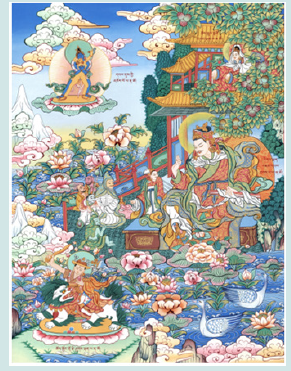
Figure 3: The green circle represents the Mount Meru (Sumeru). Surrounding the green circle, there are three blue circles, three red circles, three yellow circles and three white circles, all of which are presenting the twelve main planets in this world. The large blue circle represents our earth. A world in Buddhism refers to the Mount Peru, Sun, moons, the twelve main planets (called four major and eight minor continents) as well as other smaller objects called islands. Shambala is on the north side of the earth, and literately called Shambala Illusory Continent. There are eight suburban regions and one central urban region in Shambala. They have yellow-color legendary tunnels connecting the earth. Note: the drawing is not according to the real scale; for example, the Mount Meru should be much larger than the twelve planets.
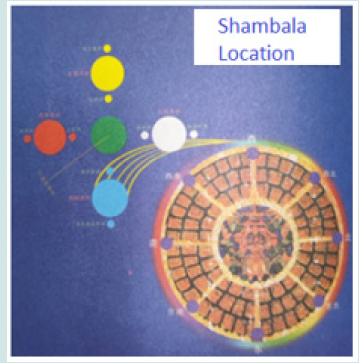
Figure 4: The Tibetan Map of Shambala, that was drawn in 16th century. This map shows the eight suburban areas and one central (urban) area. The map was drawn by the reputable monk, the Karmapa VIII, Migyo Doje, one of spiritual leader of Tibetan Buddhism.
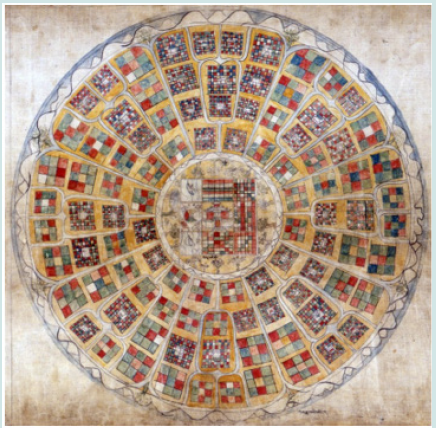
Figure 5: The Yidam of Kalachakra. Although it has the male and female in union practice, religiously, it is deemed as one entity. It is also called Buddha Kalachakra, who can have any manifest body as woman and/or man with different numbers of faces, legs, and arms. It steps on the deities, who were worshiped in some cultures, to show that the Kalachakra has higher enlightenment status than others.
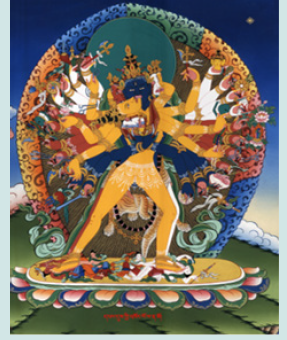
Figure 6: King Suchandra, the first Dharma king of Shambala. He received the teaching from Buddha and preach dharma as a king.

Figure 7: The Tangka showing the 25 Kings of Shambala, including the King Manjuśrīkīrti and his descents. All of them have the title “Good Moon King”. It is noteworthy that they are not the only kings in Shambala - there are kings before them and after them. There are 28 figures in this Tangka. The upper middle two figures are gu-rus who preached dharma on the earth. The middle figure is the Yidam of Kalachakra. The Yidam is a god-like being, able to change the numbers of legs and arms. Thus, its appearance could be different between different Tangkas.
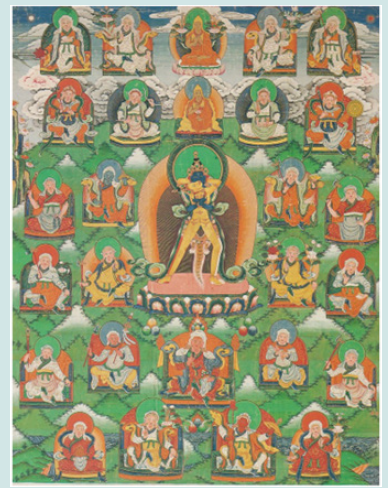
Figure 8: The Tangka that describes the future War of Shambala. In the right side of this painting, the dou-ble-circle wheel represents Shambala. The upper left shows one of Shambala’s weapons called “Wind (Cloud)” which is capable of flying above enemy and pouring down hot oil to burn enemy soldiers. The red car in the bottom of this painting shows another Shambala’s weapon, the Arrow Machine, which can shoot arrows con-tinuously to the enemy.
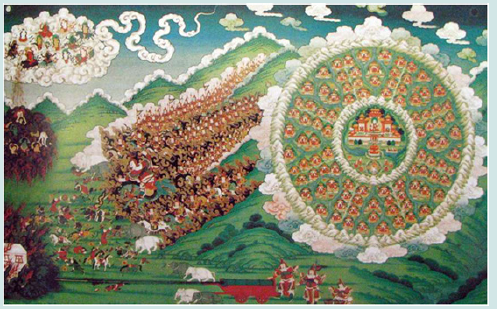
Figure 9: The Mandala of Kalachakra. The mandala is the “city” where the Yidam Kalachakra lives in. The outside ring represents a firewall that protects the mandala. Only Buddha or highly-enlighten Boddhisatva can go through the firewall freely. Otherwise, invitation is required in order to enter the mandala of Kalachakra. There are four doors in this mandala. The white color indicates the east gate, red for west, yellow for south and black or green for north. It is note-worthy that this Tangka is draw in a star-map view point: the east and west reversed. When using a star map, you are looking up at the sky (think: lying flat on your back), so when North is above your head, your feet are to the South, West to the right, and East to the left.
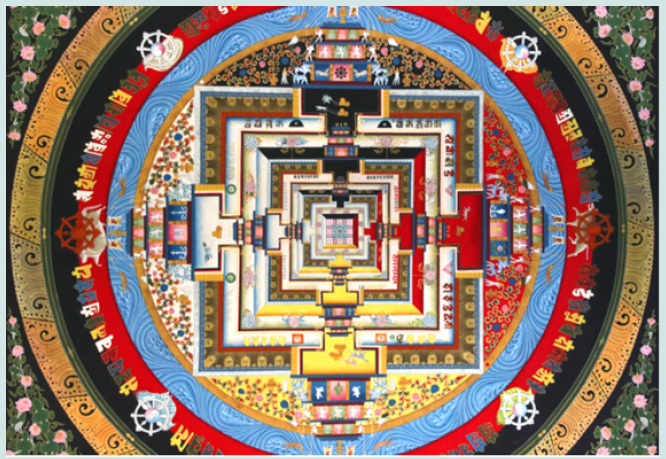
As illustrated in Figure 3, Shambala is not on our earth. It is a planet located on the north side of the earth, and literately called the Shambala Illusory Continent. Similar as ancient Greek philosophers thought there are Luminiferous aether (ether) that fills the universe like water, Buddhism refers the planets as continents in the ocean (because the saints were able to see ether-made water) and named the planets as continents and smaller objects as islands. There are eight suburban (Ga-lin-bu-ri) regions and one central urban region in Shambala (Figure 4). The King lives at his palace in the urban region. Their plants, such as the grasses and flowers, look similar as those in the earth. In each of the eight suburban regions, there is one army troop composed of 1.8 billion people. Totally there are eight of such troops. The leader of each troop is called the Big Commander of Sword, who are awarded a diamond seal and a green pearl by the King of Shambala. The function of army is to protect Buddhism. Comparing with the human population on the earth which is 8.2 billion, the Shambala Shambala is more populous, with more than 14.4 billion (1.8 billon soldiers per each suburban area x8 plus the urban population plus civilian population in the suburban area). If they have the similar population density as United States which has 38 persons per square kilometer, it will need 379 million km2 to host its 14.4 billion army population. If Shambala people lives as condensed as Japan which has 336 people per square kilometer, it will need 43 million km2.The earth surface area is 362 million km2. Considering spherical geometry, at least, Shambala should be bigger than 4% of the earth. That is why the Shambala is called as the Shambala Continent rather than an island. Located on the north of our earth, the Shambala realm is actually not too far from the earth. Just like an invisible airplane, it has not been discovered by current technology yet; but will be surely discovered in future. The people in Shambala are always able to see our earth in all of their four seasons, the spring, summer, autumn and winter. Looking from the universe background, no matter how the earth rotates, its east and west directions could be relative, but the north and south are unchangeable. The Shambala is always on the north of the earth. According to Buddhism teaching, there are twelve main planets in this solar system [2]. Each of the twelve has their unique name. There are four major human habitats, which are called the Four Major Continents (Planets). In addition to the four planets, there are eight other planets where human can live. These eight planets are called Eight Minor Continents (Planets). In addition to the twelve planets, there are over 84000 objects where human live in this world. A world in Buddhism refers to the Mount Meru, Sun, moons, the twelve main planets (called four major and eight minor continents) as well as other smaller objects called islands. The Shambala was not considered as one of the twelve main planets because it will disappear in future. It is believed to be illustrated by the Yidam (God-like being) Kalachakra (Figure 5) and will return to the Yidam Kalachakra after accomplishing the dharma preach on the earth. Therefore, the full name of Shambala is Shambala Illusory Continent.
King Lineage. The first King who received the teaching from Siddhartha Buddha is called King Suchandra (Figure 6). It is noteworthy that the exact years about the life of the Buddha, Siddhartha Gautama, is not solved yet; historians have different opinions, because of the loss of records in India and surrounding regions after the Muslim Conquest. Since this king lived in a same age as the Buddha, he should live around 3000 years ago or 2700 years ago depending on the calculations used by historians to determine Buddha’s birthday. King Suchandra is called Dharma King because his meditation success and his preaching of Buddhism. Through continuous efforts of many generations of Dharma Kings, the Shambala was finally turned into a Buddhism kingdom. The King Suchandra and his descents have seven generations of kings. Then, the King position was taken by the families of Manjushri Yashas, who is the aforementioned King Manjuśrīkīrti. It is noteworthy that the King Manjuśrīkīrti (born in 159 BC) is different from the famous Manjusri Boddhisatva who is a Buddha-like noble person. King Manjuśrīkīrti took this name because he was a spiritual follower of Manjusri Boddhisatva. In Tibet religions, he was deemed as an incarnation of Manjusri Boddhisatva. It is predicted that the King Manjuśrīkīrti and his descents will last for twenty-five generations (Figure 7); all these kings are having/will have the words of “Moon Good King” in their titles. For example, the full name for the 25th king will be called Forceful Wheel Holder (Raudra Chakrin) Moon Good King. After “Moon” Kings, the next batch of kings will have the words of “Sun Good King” in their titles; after that, the next next batch of kings will have another pre-fixed word in their titles; and so on for seven batches. The famous legend, War of Shambala (Figure 8), will happen during the time of the above-mentioned 25th Moon Good King (Raudra Chakrin). Many scholars, who have studied time wheels, think that this event will happen in 25th century when the earth will be ruled by barbarians who will invade Shambala. Other scholars thought it might not happen since Buddhists love peace.
According to the American author Alice A. Bailey, Shambala was “an extra-dimensional or spiritual reality.” To date, there is no scientific way to reach an extra-dimensional or spiritual reality. If the Ti-betan legend on the War of Shambala is true, the aforementioned special (space-time) tunnels could really exist. It is just a matter of time for human to discover them. According to the legend, the future mankind will have higher technology to find Shambala. They have advanced technology, but their health conditions, happiness levels, spiritual statuses and life spans are worse than current human beings due to the decline of morality. At the time when the location of Shambala is discovered, the earth will be ruled by barbarian rulers who would invade Shambala. The above-mentioned armies in the eight suburban (Ga-lin-bu-ri) regions will protect Shambala. Also, the Shambala King has very powerful weapons [4] according to the Kalachakra Tantra and will defeat the barbarians. Then, the Shambala King will rule over the earth and lead people to practice Kalachakra for twenty thousands of years. The preaching will help billions of people. After that, they will retreat and the land of Shambala will disappear into the Kalachakra mandala (Figure 9), who will then disappear into higher dimension.
Discussion
Religious books/scriptures/paintings provide a novel view on the exist of Shambala. As aforemen-tioned, the formal nomenclature for Shambala is: Shambala Illusory Continent. “Illusory” means that Shambala appears from a higher dimension down to our dimension, and will disappear and return into the higher dimension This higher dimensional realm is called Akaniṣṭha (meaning “unsurpassed form”) where is deemed as a pure land and where the Sambhogakaya (a body form of Buddha) lives. From the point view of current cosmology, the Shambala is like a mother spaceship; but it is different: normal humans, instead of aliens, live in Shambala. The ship is not only made by metal, but made of the same elements and configurations as the earth. It is unbelievable like a dream, so it is called “Illusory”. Con-tinent refers to a big piece of land surrounded by waters. Here, the waters are not necessary composed of H2O. The Holy Bible [5] also mentioned that there is water above the sky (in space), but it does not mention the water has to be made of H2O. Ancient philosophers thought there are Luminiferous aether (ether) that fills the universe like water. In fact, no modern experience, including the known MM Ex-periment which has technical limitations [6], can deny the exist of either. Since many saints were able to see the ether-made water, they named the planets as continents (lands flowing in the water). Thus, the name of Shambala Illusory Continent refers to a large land-like object (e.g. planet) flowing in the space, which can appear or disappear like illusion. It is noteworthy that each planet has a unique name in Buddhism, known by the Shambala people. Our earth is called Jambudvipa (sometimes translated as Yanfuti) by Buddha, because there are tree-like dark matters like a very huge giant Jambu tree which is rooted from (connect to) our earth. The tree is like a dark matter that is visible to Buddha but invisible to human, but we can see its shadow on moon [2,7]. In Shambala, people call our earth as the South Jambu Continent. In previous text, we mentioned there are twelve planets. This number is in line with the twelve planets defined by the Sumerian culture and the new twelve-planet motion proposed by International Astronomical Union [8], though it is not clear whether they are referring to exactly same planets. As aforementioned, a world in Buddhism definition is more like our solar system. According to Buddha, a small-thousand world is composed of over 1000 of such world; a medium-thousand world is composed of over 1000 of the small-thousand world; a large-thousand world is composed of over 1000 of the medium-thousand world. This is where the saying of “three thousand realms (should be: 1000 to the power of 3)” originally came from. One large-thousand world is the territory for one Buddha who is preaching his dharma. The compassionate Shakyamuni Buddha is not only delivering teaching in this world, but also in the tens of billions of earths in the large-thousand world. Each world, each small-thousand world, each middle-thousand world, and each large-thousand world has a unique name. Our largethousand world is called the Suopo (meaning: able-to-tolerant) World, where Shakyamuni Buddha preaches Buddhism. Thus, one large-thousand world is also called one Buddha Territory. Out of the Suopo World, there are other large-thousand worlds. The wellknown Pureland of Amitabha Buddha has the formal name as the Extremely Happy World, where Amitabha is preaching Buddhism. There are millions of Juzhi Nayuta Buddha Territories in between the Amitabha Buddha Territory and our Suopo World, as told by Shakyamuni Buddha and documented in the Amitabha Sutra. Juzhi and Nayuta are ancient math terminologies. According to Huayan Sutra, one Juzhi is 10 million; the square of Juzhi is equal to one Ayuduo; the square of Ayuduo is equal to Nayuta, which should be 10^28. Some scholars think one Nayuta could be 100^39, 10^60, 10^112 or 10^64. After all, there are at least 1041 (1 million x 1 Juzhi x 1 Nayuta) Buddha Territories from our world to Amitabha’s pure land. Some people thought one large-thousand world is equal to a galaxy [9], though this is not confirmed yet. If this is true that one Buddha Territory will be equal to one galaxy, the number of galaxies is far more the observation limit of current science framework – to date, there are only 100 billion galaxies observed by current cosmologists [10]. Comparing with the enormous universe, our earth is just like a small sand.
The human in Shambala could be an example of parallel civilization as mentioned in scientific paper [6] or they migrate from the earth originally. Anyway, it is impossible to evolve from monkey [11]. As a matter of fact, they are same as the humankind on the earth. According to the Time-Wheel (Kalachakra) theory, human breathes 21600 per day, which is 4 second per breath, as normal as an average human being. According to Kalachakra practice, there are 72,000 energy channels inside human body. One channel will be closed each day during a man’s life. Thus, a person can live for as long as two hundred years if the channels are closing in normal speed. Because of the decline of morality, the bias and negative karma, the channels are closing in a faster speed, even more than doubled. Thus, most human beings on our planet cannot live for 100 years. The people in the Shambala Illusory Continent have longer life spans because of better ethics and good practices of Time-Wheel meditation; thus, the closing speed of their energy channels were obviously slower than the counterpart in the earth (the South Jumbo Continent). Comparing with us, they are living in a paradise with high freedom. There are tunnels that they can travel to/from the earth freely; but not vice versa for human on the earth. It is more like the US-Mexico border, where US citizens can travel through freely, but only a few Mexicans can go through. There are protectors like the security guards: only a handful of persons with high mortality from the earth can travel to Shambala. However, Shambala is not equal to the Pureland of Amitabha Buddha. The Pureland of Amitabha is extremely purer, and it refers to a land where everything is absolutely pure: people has very high ethic standard, so there is no need for a human king; there is no castle system, no taxes and no government; people could live forever.
The aforementioned text stated that the Shambala will disappear about accomplishing the preaching. Then, how about the earth? The earth again will enter the dark age. At that time, the new generations of people, who are born in the earth, have strong negative karma that form obstacles against Tantrayana teaching. For example, they could have insulted Tantrayana and strongly wished not to learn any tantra during their previous lives; these behaviors produced strong negative karma that form boundaries to block them from Kalachakra. Thus, they are unsuitable to the Kalachakra Buddhism. Therefore, the Shambala will withdraw and leave them alone. The generations of people that were born to the earth after the Shambala Preaching will forget normal religions and ethics. According to Agama Sutra, the dark age will keep going until people can only survive for 10 years. At our time, we praise people for doing good deeds. When we wish somebody to live longer, we said “wish you to live to as long as 100 years”. At that dark age, people praise each other for doing bad deeds. When we wish somebody to live longer, we said “wish you to live for 10 years”. Many nice stuffs, such as sugar, honey and cheese, will disappear because of people’s negative karma, lack of enough education and bias. Disasters, like famine, disease and war, will arise, and take lives of most people. After the darkest age of human, there will be very few human survived. They will feel lucky to meet one another and learn to repent. The Buddhism Dharma has extinguished at that time, but there will be incarnations of merciful Boddhisatvas that show up as general human images to teach people to do good deeds and give them another chance. The Boddhisatva incarnations will awake people and teach people the techniques that they lost (e.g. how to build a house and do agriculture). For example, the Maitreya Boddhisatva will show up as a person living very long. People will ask him why he can live so long; he will tell people the secret: doing good deeds by good hearts. After repenting, the people will learn to do good things; gradually they will increase the life span; their health condition will be back to normal. By keep doing more and more good things, their life spans will become very long and their health conditions will be much better, and their heart will be even purer than current human generations. Anyway, human will have a bright future according to Buddhism.
Acknowledgements
W.S. would thank the great people who are able to preserve the religious records/books for thou-sands of years. Generation by generation, with tremendous efforts. Moreover, the author would greatly thank those guru masters who have the capabilities to observe Shambala and make authentic records.
References
- Berzin A (2011) Introduction to the Kalachakra initiation. Shambhala Publications.
- Sun W, Sun, J (2024) The History of Human Civilization from the Religious Views. J Anthro & Archeo Sci 9(5): 1279-1293.
- Rinpoche Tuoshi (1998) Winsdom Burst from Heart. Lanzhou: Gansu People Publisher.
- War of Shambhala (2014) Shambhala War. Retrieved from Tibetan Buddhist Encyclopedia.
- Bible (1973) The Holy Bible (NIV Version). Colorado Springs, CO, USA: International Bible Society.
- Sun W (2024) Solving the Olbers’s Paradox, Explaining the “Red-Shift”, and Challenging the Relativities by "Sun Matters Theory" and "Sun Model of Universe", an Evolution of Einstein's Static Universe Model. Natural Science 16(2): 7-18.
- Sun W (2024) Secrets of Universes. Chisinau: Generis Publishing.
- Cain F (2006) Officials Propose 12 Planets in the Solar System. Retrieved from Universe Today.
- Three-Thousand Large Thousandfold World. (2014) Three-Thousand Large Thousandfold World. Retrieved from Tibetan Buddhist Encyclopedia: Thousand_Large_Thousandfold_World.
- Eicher D J (2020) How Many Galaxies Are There? Astronomers Are Revealing the Enormity of the Universe. Retrieved from Discover.
- Sun W (2024) Solving the Darwinian Paradoxes by “Sun Model of Civilization”, Re-Examine the Origin of Human. J Anthro & Archeo Sci 9(2): 1200-1211.

Top Editors
-
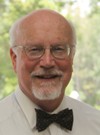
Mark E Smith
Bio chemistry
University of Texas Medical Branch, USA -

Lawrence A Presley
Department of Criminal Justice
Liberty University, USA -

Thomas W Miller
Department of Psychiatry
University of Kentucky, USA -

Gjumrakch Aliev
Department of Medicine
Gally International Biomedical Research & Consulting LLC, USA -
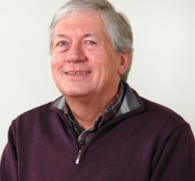
Christopher Bryant
Department of Urbanisation and Agricultural
Montreal university, USA -

Robert William Frare
Oral & Maxillofacial Pathology
New York University, USA -

Rudolph Modesto Navari
Gastroenterology and Hepatology
University of Alabama, UK -

Andrew Hague
Department of Medicine
Universities of Bradford, UK -

George Gregory Buttigieg
Maltese College of Obstetrics and Gynaecology, Europe -

Chen-Hsiung Yeh
Oncology
Circulogene Theranostics, England -
.png)
Emilio Bucio-Carrillo
Radiation Chemistry
National University of Mexico, USA -
.jpg)
Casey J Grenier
Analytical Chemistry
Wentworth Institute of Technology, USA -
Hany Atalah
Minimally Invasive Surgery
Mercer University school of Medicine, USA -

Abu-Hussein Muhamad
Pediatric Dentistry
University of Athens , Greece

The annual scholar awards from Lupine Publishers honor a selected number Read More...




